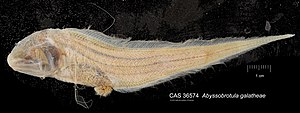Abyssobrotula galatheae
| Abyssobrotula galatheae | ||||||||||||
|---|---|---|---|---|---|---|---|---|---|---|---|---|

Abyssobrotula galatheae |
||||||||||||
| Systematics | ||||||||||||
|
||||||||||||
| Scientific name of the genus | ||||||||||||
| Abyssobrotula | ||||||||||||
| Nielsen , 1977 | ||||||||||||
| Scientific name of the species | ||||||||||||
| Abyssobrotula galatheae | ||||||||||||
| Nielsen, 1977 |
Abyssobrotula galatheae is a deep-sea fish from the male bearded family(Ophidiidae). It lives worldwide in tropical and subtropical regions of all oceans between 46 ° N and 48 ° S. Its habitat is the Abyssal and Hadal at depths below 3100 meters. A specimen of Abyssobrotula galatheae , which wascollectedat a depth of 8370 meters in the Puerto Rico Trench , was considered tobe the deepest fish find until the discovery of Pseudoliparis swirei from the family of the disc bellies (Liparidae). However, the specimen was already dead and therefore it is not clear whether the fish actually lived there. Another fish that has been shown to live in the greatest depths of the sea is Pseudoliparis amblystomopsis , which wasfilmedin the Japan Trench at a depth of 7700 meters.
features
Abyssobrotula galatheae becomes 16.5 cm long. Like all male beards, it has an elongated body that is flattened at the rear and is surrounded by a fin edge made of dorsal, caudal and anal fins that have grown together. The head is short and directed downwards, the mouth below, the muzzle swollen. The eyes are small. A slightly developed thorn sits on the gill covers. The anterior gill arches have eight to eleven gill trap rays . Abyssobrotula galatheae has paired tooth plates on the basibranchial (bone at the base of the branchial arch). The pectoral fins are supported by ten to eleven fin rays, the throaty ventral fins are reduced to two fin rays . The number of vertebrae in the abdomen is 18-21.
Way of life
Abyssobrotula galatheae is rare and its way of life is unknown. It is believed that, similar to other oviparous bearded males, it lays pelagic eggs that are held together by a gelatinous mass.
literature
- Nielsen, JG; Cohen, DM; Markle, DF; Robins, CR: Ophidiiform fishes of the world (Order Ophidiiformes). An annotated and illustrated catalog of pearlfishes, cusk-eels, brotulas and other ophidiiform fishes known to date. FAO Fisheries Synopsis. No. 125, vol. 18. Rome, FAO . 1999. PDF
Web links
- Abyssobrotula galatheae on Fishbase.org (English)